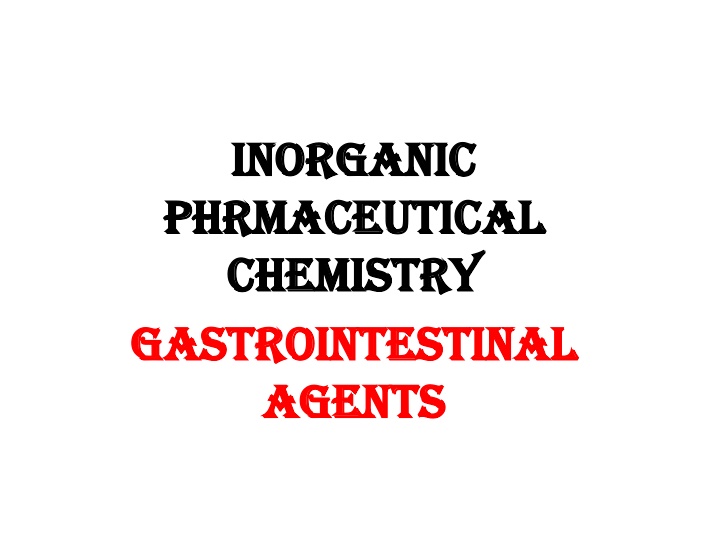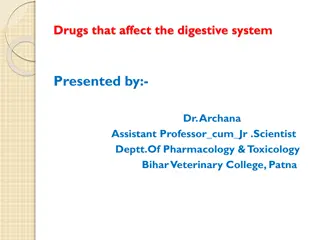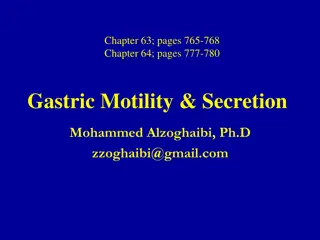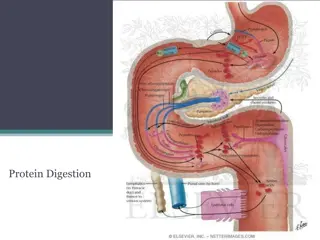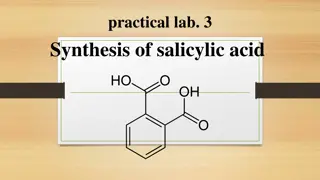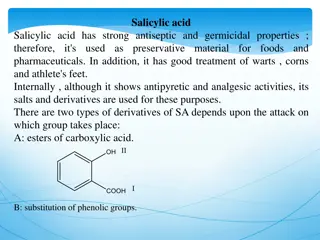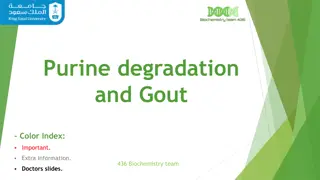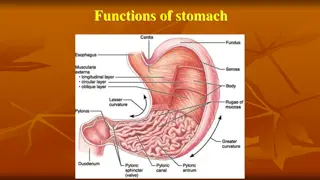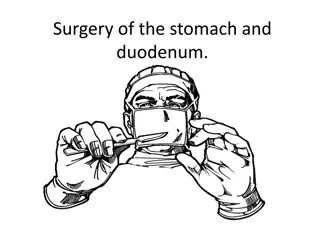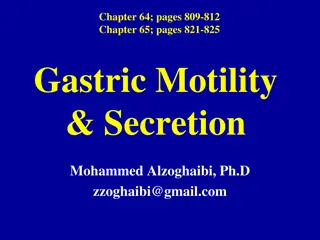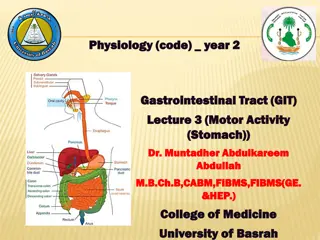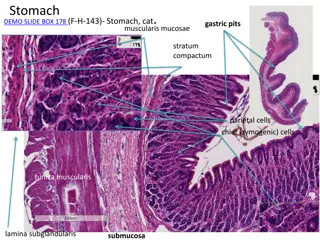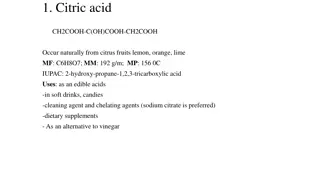Stomach Function and Acid-Related Diseases
The stomach secretes various substances including hydrochloric acid, mucus, and prostaglandins to aid in digestion and protect the mucosa. Key cells like parietal cells and chief cells play essential roles. Understanding these processes is crucial for managing acid-related diseases like achlorhydria, which can lead to symptoms such as epigastric pain and diarrhea.
Download Presentation

Please find below an Image/Link to download the presentation.
The content on the website is provided AS IS for your information and personal use only. It may not be sold, licensed, or shared on other websites without obtaining consent from the author.If you encounter any issues during the download, it is possible that the publisher has removed the file from their server.
You are allowed to download the files provided on this website for personal or commercial use, subject to the condition that they are used lawfully. All files are the property of their respective owners.
The content on the website is provided AS IS for your information and personal use only. It may not be sold, licensed, or shared on other websites without obtaining consent from the author.
E N D
Presentation Transcript
Inorganic Inorganic phrmaceutical phrmaceutical chemistry chemistry Gastrointestinal Gastrointestinal Agents Agents
The stomach secretes: -Hydrochloric acid(HCL) -Bicarbonate -Pepsinogen -Intrinsic factors -Mucus -ProstaglandinsParts of stomach and their lining cells
prostaglandins The prostaglandins are a lipid compounds having hormone-like effects formed by the gastric mucosa. Prostaglandins have been shown to protect against gastric and duodenal mucosal damage in animals and humans.
Intrinsic factor (IF), cobalamin binding intrinsic factor, also known as gastric intrinsic factor (GIF), is a glycoprotein produced by the parietal cells (in humans) of the stomach. It is necessary for the absorption of vitamin B12. parietal cell
Cells in the Gastric Gland Parietal Cells Produce and secrete HCl Primary site of action for many acid controller drugs. Chief cells (peptic cells) Secrete pepsinogen, a pro enzyme Pepsinogen becomes pepsin when activated by exposure to acid Pepsin breaks down proteins (proteolytic)
Mucoid cells Mucus-secreting cells (surface epithelial cells), secrete mucus and bicarbonate, This mucus-bicarbonate barrier is an important first line of defence against damage pepsin by gastric acid and Hydrochloric Acid Secreted by the parietal cells when stimulated by food Maintains stomach at pH of 1 to 4 Secretion also stimulated by: Large fatty meals Excessive amounts of alcohol Emotional stress
Acid Related Disease Achlorhydria is the medical term for a lack of stomach acid (hydrochloric acid) due to the failure of the parietal cells to produce gastric acid. Patient with achlorhydia suffering from epigastric pain, frequent bowel movement and diarrhea Causes 1-Gastric atrophy This is a result of chronic inflammation of the gastric mucosa and there is a loss of glandular gastric cells.
2-Chronic gastritis usually due to Helicobacter Pylori (H. pylori) infection. 3-Autoimmune gastritis as a result of antibodies against the parietal cells which seen in pernicious anemia. 4-Drugs Long term use or excessive use of the following drugs may result in iatrogenic achlorhydria. Proton Pump Inhibitors (PPI s) These drugs work by inhibiting the H+/K+ ATPase enzyme pump which is responsible for transporting hydrogen and the subsequent production of HCl.
Histamine H2-Receptor Antagonist Also known as H2 blockers, decrease gastric acid secretion by reversibly binding to histamine H2 receptors located on gastric parietal cells, thereby inhibiting the binding and activity of the endogenous ligand histamine. 5-Tumors Gastric cancer Tumors that affect the fundus of the stomach are more likely to result in achlorhydria as it destroys the parietal cells which are responsible for the secretion of HCl.
6-Surgery Gastric resection for the treatment of certain stomach conditions like antroctomy or certain types of weight loss surgery Achlorhydria treated by use 0.1 N HCL
Hyperacidity (overproduction of HCL) Caused by -imbalance of the three cells of the gastric gland and their secretions. - H. pylori -Bacterium found in GIT Symptoms of hyperacidity are: A burning sensation in the chest (heartburn), usually after eating, which might be worse at night or while lying down. Regurgitation of food or sour liquid. Upper abdominal or chest pain. Trouble swallowing (dysphagia). Sensation of a lump in the throat
Gastric mucosal defense mechanisms Secretion of : 1-Mucus: protective barrier against HCL 2-Bicarbonate: helps buffer acidic properties of HCL 3-Prostaglandins:prevent activation of proton pump which result in decrease HCL production
Types of Acid-Controlling Agents 1-Antacids 2-H2 antagonists 3-Proton pump inhibitors Antacids: Mechanism of Action -Antacids DO neutralize the acid once it s in the stomach -Antacids DO NOT prevent the over-production of acid and not cause systemic alkalosis -Reduction of pain associated with acid-related disorders -Raising gastric pH from 1.3 to 1.6 neutralizes 50% of the gastric acid -Raising gastric pH (1.3 to 2.3) neutralizes 90% of the gastric acid, generally ideal antacid buffer in the pH range 4- 6 Used alone or in combination Used alone or in combination
Antacids: Aluminum Salts Have constipating effects Often used with magnesium to counteract constipation Delay onset, but long duration of action Contraindication for patient with hypophosphatemia Examples : Aluminum carbonate, Hydroxide salt, combination products (aluminum and magnesium): Gaviscon, Maalox.
Antacids: Magnesium Salts Forms: carbonate, hydroxide, oxide, trisilicate -In addition to the GI irritation magnesium salts cause watery diarrhea, usually used with other agents to counteract this effect -Contraindicated with Renal failure because the patients cannot excrete extra magnesium leading to Hypermagnesemia -Delay onset but long duration of action -Combination products such as Maalox, Gaviscon (aluminum and magnesium).
Antacids: Calcium Salts Forms many, but carbonate is most common. May cause constipation, kidney stones and renal failure in addition to the hyperphosphatemia Burnett syndrome is occur due to prolong used of calcium containing antacid Delay onset, but long duration of action Example: calcium carbonate
Calcium amphoteric effect but they depend on their basic properties and not cause systemic alkalosis. containing antacid do not have Milk-alkali syndrome: is a condition in which there is a high level of calcium in the body as a result, there can be a loss function. of kidney
Antacids: Sodium Bicarbonate Highly soluble Buffers the acidic properties of HCl Quick onset, but short duration May cause metabolic alkalosis Sodium content may cause problems in patients with HF, hypertension, or renal insufficiency (fluid retention) The ideal neutralizing capacity of an antacid should be at least 5 meq. of HCL per dosage unit.
Antacids and Antiflatulents Antiflatulents: used to relieve the painful symptoms associated with gas, several agents are used to bind or alter intestinal gas by reducing the surface tension of bubbles in the stomach and are often added to antacid combination products. Examples Activated charcoal and simethicone Alter elasticity of mucous-coated bubbles causing them break Antacids side effect: 1-Aluminum and calcium = Constipation 2-Magnisum = diarrhea 3-Calcium carbonate Produces gas and belching; often combined with simethicone
Antacids contraindictions 1-Renal disease 4-GI obstruction 5-Pregnancy 6-Allergy 2-Fluid imbalances 3- HF -Patients with HF or hypertension should use low-sodium antacids. -Use with caution with other medications due to the many drug interactions -Most medications should be given 1 to 2 hours after giving an antacid -Antacids may cause premature dissolving of enteric-coated medications, resulting in stomach upset -Be sure that chewable tablets are chewed thoroughly, and liquid forms are shaken well before giving -Caffeine, alcohol, harsh spices, and black pepper may aggravate the underlying GI condition
Antacid: Drug interactions -Adsorption of other drugs reduces the ability of these drugs to be absorbed into the body - Chelation Chemical binding or inactivation of another drug produces insoluble complexes, result in reduce drug absorption Antidiarrheals Diarrhea Abnormal frequent passage of loose stool or Abnormal passage of stools with increased frequency, fluidity, or increased stool water excretion
Antidiarrheal drugs act as adsorbents: -Coat the walls of GIT -Bind to the causative agents(bacteria or toxins) and eliminated them with stool examples: Bisumth subsalicylate, Kaolin-pectin, Activated charcoal(Kaopectate) Side Effects Adsorbents -Increased bleeding time -Constipation, dark stools -Confusion, twitching Hearing loss, tinnitus, metallic taste Antidiarrheal Agents: Interactions Adsorbents decrease the absorption of many drugs including digoxin, clindamycin, quinidine, and hypoglycemic agents Adsorbents cause increased bleeding time when given with anticoagulants.
Acute diarrhea Sudden onset in a previously healthy person lasts from 3 days to 2 weeks, self-limiting Chronic diarrhea Lasts for more than 3 weeks Associated with recurring passage of diarrheal stools, fever, loss of appetite, nausea, vomiting, weight loss, and chronic weakness Causes of Diarrhea: Acute Diarrhea Bacterial Viral Protozoal Drug induced Nutritional Chronic Diarrhea Tumors Diabetes Addison s disease Hyperthyroidism Irritable bowel syndrome
Laxatives(Cathartics) Constipation Abnormally infrequent and difficult passage of feces through the lower GI tract due to the disorder of movement in the colon and/or rectum It is not a disease Can be caused by a variety of diseases or drugs Act by: Bulk forming -Absorbs water to increase bulk -Distends bowel to initiate reflex bowel activity Examples: psyllium (Metamucil) methylcellulose (Citrucel) Polycarbophil (FiberCon)
Emollient Stool softeners and lubricants Promote more water and fat in the stools(docusate salts) Lubricate fecal material and intestinal walls (mineral oil) Hyperosmotic Increase fecal water content Bowel distention, increased peristalsis and evacuation, examples: Polyethylene glycol Sorbitol(increases fluid movement into intestine) Glycerin Lactulose Saline Increase osmotic pressure within the intestinal tract causing more water to enter the intestines
bowel distention, increased peristalsis, and evacuation, should not be given to patient with low sodium diet. Examples: magnesium sulfate magnesium hydroxide magnesium citrate sodium phosphate Stimulant Increases peristalsis via intestinal nerve stimulation leading to local irritation of intestinal tract. Examples: castor oil senna cascara
Laxatives: Indications Bulk forming Acute and chronic constipation and Irritable bowel syndrome Emollient Softening of fecal impaction; facilitation of BMs in anorectal conditions Hyperosmotics Chronic constipation Diagnostic and surgical preps
Saline Removal of helminths and parasites Diagnostic and surgical preps Stimulant Acute constipation Diagnostic and surgical bowel preps
Side Effects of laxatives: Bulk forming Impaction Fluid overload Emollient Skin rashes Decreased absorption of vitamins Hyperosmotic Abdominal bloating Rectal irritation
Saline Excessive loss of body fluid in form of watery stools Magnesium toxicity (with renal insufficiency) Cramping Diarrhea Increased thirst Stimulant Nutrient malabsorption Skin rashes Gastric irritation Rectal irritation All laxatives can cause electrolyte imbalances
